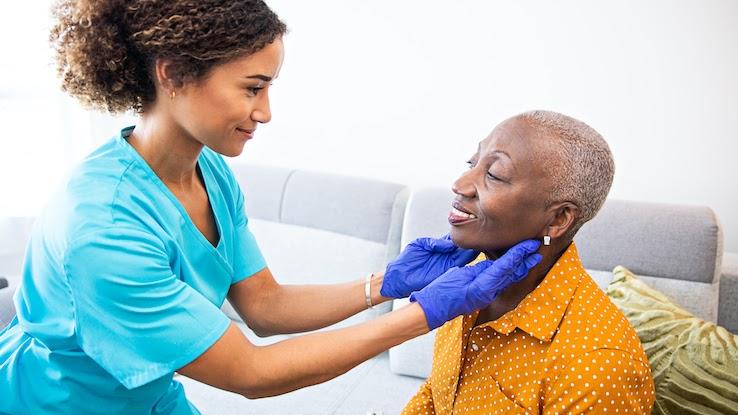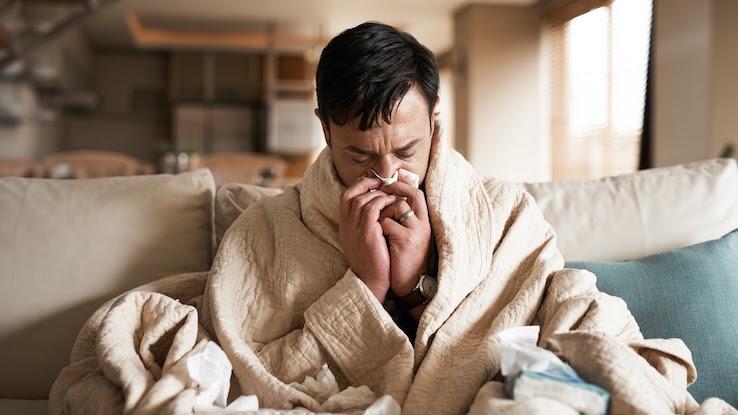
Lymph nodes, which are small nodules found throughout your body, are an integral part of your immune system. Lymph nodes facilitate “communication” between various defense cells that fight off infection and foreign bodies to keep you healthy. When you’re experiencing an infection, your lymph nodes may feel or appear swollen because the cells within them are actively fighting the pathogen causing the infection. This enlargement is usually normal, but you should have a healthcare provider take a look if the swelling persists much longer than the duration of your illness.
Lymph nodes are found in various areas around your body, such as your groin, the sides of your neck, behind your ears, your underarm/armpit region and below your jaw. Though you can feel some nodes with your fingers, it’s not abnormal at all to be unable to locate your lymph nodes by touch.
Causes of Swollen Lymph Nodes
Most people experience swollen lymph nodes during periods of infection. These infections can range from the common cold to gingivitis to a number of sexually transmitted infections (STIs). Some autoimmune disorders can lead to swollen lymph nodes as well, namely rheumatoid arthritis, lupus and acquired immunodeficiency syndrome (AIDS).

More rarely, the root cause of swollen lymph nodes could be related to the development of cancer. Cancers that affect the blood, such as leukemia and Hodgkin or non-Hodgkin lymphoma, are the cancers most commonly known to cause lymph node swelling. Cancer that originates in other areas of the body can also migrate, or metastasize, to the lymph nodes. People who take certain seizure medications may also find themselves experiencing swollen lymph nodes.
If you have swollen lymph nodes, you should monitor the progression of the swelling. Typically, swelling or pain that arises suddenly isn’t as concerning as painless lymph nodes that get larger progressively over time.
Symptoms of Swollen Lymph Nodes
The major and most noticeable symptom of a swollen lymph node is a small lump you can feel underneath your skin. You might easily feel these lumps by pressing into your skin. However, not all swollen lymph nodes are large enough that you can feel them. Lymph nodes of the armpit, called axillary lymph nodes, are typically the size of a pea. If your swollen gland doesn’t reduce in size, seems to be fixed in place, isn’t painful and gradually gets larger, you should seek care from a medical professional.

How Swollen Lymph Nodes Are Diagnosed
Your healthcare provider can perform an initial diagnosis of a swollen lymph node simply by palpating (touching) the affected area. If your practitioner is concerned at all that your swollen node is due to a more serious condition, such as cancer or an autoimmune disease, they may order further diagnostic tests. These tests may include imaging, such as an X-ray, a biopsy (tissue sample) or blood tests to assess the function of your liver, kidneys and metabolic processes.

Your doctor will likely order a test called a complete blood count (CBC) to measure the number of various blood cells in your system. Elevated white blood cell levels may indicate an infection, while an abnormally low red blood cell count could show signs of a blood-based cancer, such as leukemia.
Treatment Options for Swollen Lymph Nodes
Treatments for swollen nodes depend on the root cause of the immune response that’s causing them to swell. If you have a bacterial infection, your healthcare provider may prescribe a course of antibiotics. If the swollen lymph nodes developed after an allergic reaction, you may require an antihistamine medication. In some cases, medication isn’t necessary, and you can alleviate the swelling by using a warm compress.

Swollen lymph nodes in the axillary (armpit) region may be concerning for certain types of cancers, specifically breast cancer, lymphoma and leukemia. Breast cancer remains particularly concerning because most of the immune reaction to breast cancer settles into the lymph nodes of the underarm region. An oncologist may recommend surgery, chemotherapy or radiation treatments to remove cancer cells, depending on the type of cancer involved. Localized cancers that haven’t spread to other parts of the body are generally easier to treat and result in better survival rates.
Resource Links:
https://www.mayoclinic.org/diseases-conditions/swollen-lymph-nodes/diagnosis-treatment/drc-20353906
https://www.mountsinai.org/health-library/symptoms/swollen-lymph-nodes





